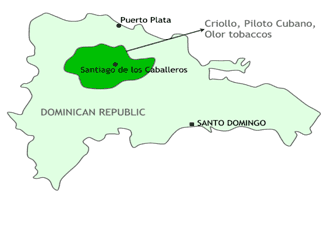So where does cigar tobacco grow?
The Western world was first introduced to tobacco, shortly after Christopher Columbus arrived in Cuba in October 1492, on his way back from his discovery of America. The two crewmen he sent ashore - Rodrigo de Jeres and Luis de Tores - first mentioned the locals smoking on land, and they took some with them on the way back. In eight years, the invention from this New World captured the Old World.
Although the first cigar tobacco was imported from Cuba and most Aficionados believe the best tobacco and handmade cigars still came from Cuba, today cigar tobacco is grown in many countries outside of Cuba.
Now let's briefly get to know these countries:
Cuba:
As we mentioned above, the place where the best tobacco grows in the world is Vuelto Abajo in the Pinar del Rio region. There are approximately 100,000 hectares of tobacco cultivated land here. The towns of San Juan y Martinez and San Luis, which are located in this locality, are known as the places where the highest class tobacco grows. San Luis is particularly famous for its wrapper leaves and one of Cuba's best tobacco growers, Alejandro Robaina, whose name was created in 1997 as a cigar brand (Vegas Robaina). It is produced at the Vegas Robaina H. Upmann factory.

Cigar tobacco of different qualities is grown in different regions of the island. An example of these is the Semi Vuelta locality, also in Pinar del Rio and famous for its filling tobacco. Remedios, which is close to the center of the island and produces lower quality tobacco, is also known with the same feature.
The best quality tobacco, after Vuelta Abajo, grows in Partido in the southwest. This place is famous for its wrapper tobacco leaves, which are mostly exported. At the same time, tobacco is grown from Connecticut seeds for export to Europe.
There are about 50 factories on the island. Around a dozen, considered the best of these, are around Havana.
Dominican Republic:
Since the American embargo on Cuba after the Fidel Castro revolution in 1962, the country where most cigar producers first settled was the Dominican Republic.
The island is also ahead of Cuba today, where the highest quality handmade cigars are produced. The island is also famous for its quality and flavored filling tobaccos. Examples of this type of high quality tobacco are the richly flavored piloto Cubano and the more neutral flavor "olor", whose seeds come from Cuba. Yaque Valley is known as the area where the best tobacco grows on the island.
Honduras and Nicaragua:
These two Central American countries share both a border and an unfortunate tobacco industry history since the eighties.
The biggest problem in Honduras, which boasts that all of its tobacco is Cuban seeds, is diseased crops. Although Cuban tobacco is very high quality, it is also the type of tobacco that is most susceptible to diseases. The 1980s were a time of such epidemics at their peak, and Honduras' crops were also heavily affected by this scourge. Honduras, which has just learned to deal with mold and diseases, is now in rising value.
In Nicaragua, where the town of Esteli and its surroundings is famous for its tobacco, the problem is that the Sandinista government soldiers' clashes with American-backed guerrillas have developed in and around this town for ten years. This land, which is constantly in conflict, mined and trenches dug, has unfortunately become offended and cannot produce quality crops. Fortunately for Nicaragua, strong development was achieved by the 1990s, and Nicaragua surpassed Mexico and Jamaica in 1996, becoming the third country to export the most cigars to the United States. Today, leading cigar brands such as Davidoff are also launching special Nicaraguan lines.


Mexico :
The state of Veracruz is home to two regions in the country where tobacco is produced. Dark local "tobacco negro" used for Maduro wrappers is grown in the north, especially tobaccos produced from Sumatra seeds used as binders and wrappers are also grown in the southern part of the state. Sumatra tobacco is famous for its silky and non-vein structure.
Ecuador :
This South American country is known for its silky and veinless high quality wrapper tobaccos produced from Sumatra and Connecticut seeds.
Brazil :
The main tobacco production in the country is carried out in the Bahia region. Local, dark and richly flavored Mata Fina type tobacco is mostly used as filling tobacco. Another type, Arapiraca, is not widely consumed today due to its weak aroma.
Connecticut :
The tobaccos produced here are proof that the highest quality tobaccos cannot be produced only in tropical regions. Connecticut Shade type tobacco is known for its silky and elastic structure and moderate aroma. Connecticut Broadleaf is mostly used as a maduro wrapper sheet and is thicker and more veined than Shade.



